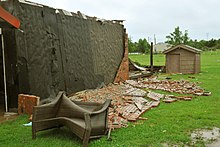This article includes a list of general references, but it lacks sufficient corresponding inline citations. (July 2013) |


Masonry veneer walls consist of a single non-structural external layer of masonry, typically made of brick, stone or manufactured stone.[1] Masonry veneer can have an air space behind it and is technically called "anchored veneer". A masonry veneer attached directly to the backing is called "adhered veneer". The innermost element is structural, and may consist of masonry, concrete, timber or metal frame.
Because brick itself isn't waterproof, the airspace also functions as a drainage plane, allowing any water that has penetrated the veneer to drain to the bottom of the air space, where it encounters flashing (weatherproofing) and is directed to the outside through weep holes, rather than entering the building.
Other advantages of a masonry veneer include:
- The air space can include additional insulation, which is typically in the form of rigid foam, increasing the thermal performance of the wall.
- The structural framing or masonry backup can be erected first to allow the rest of the building structure to be completed concurrently with the outer veneer, rather than waiting for the entire wall structure to be completed before proceeding with the roof and upper floors.
- A masonry veneer wall can be completed in a shorter time with less labor than a solid masonry wall thus saving in cost.
- The weight of a veneer wall can be significantly less than solid masonry, resulting in economies in foundations and structural support.
- Because they are a lighter-weight, more economical option, brick and stone masonry veneers can be used in place of natural stone or full brick to provide added aesthetic appeal to a structure.[citation needed]
- ^ "Manufactured Stone Veneer". ncma.org. Retrieved 2017-05-18.